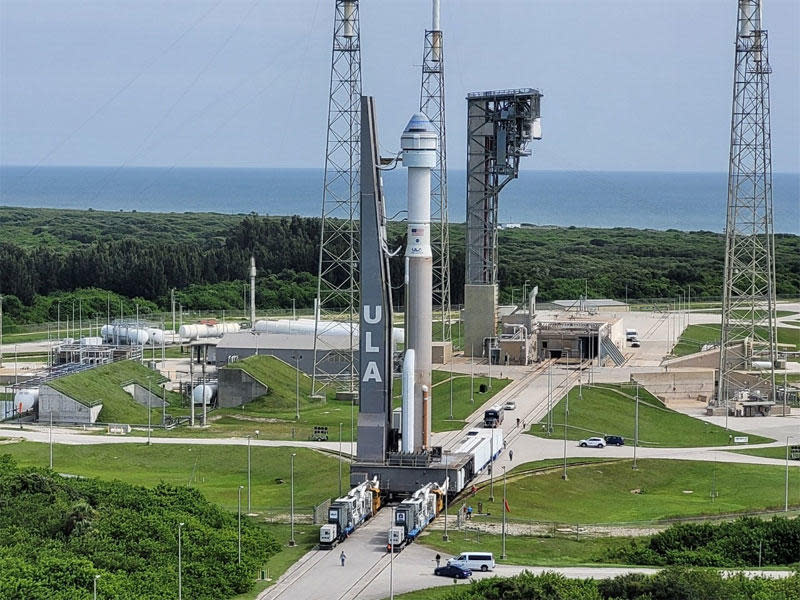Atlas 5 hauled off launch pad for Starliner troubleshooting
The Atlas 5 rocket carrying Boeing's hard-luck Starliner capsule was hauled off its Cape Canaveral launch pad Thursday and back to a processing facility for work to figure out what caused valve problems that derailed a launch try Tuesday.
Depending on what engineers discover, the Atlas 5 could, in theory, be hauled back out to the pad for another launch try late this weekend or early next week. But that assumes an easy fix and NASA concurrence with whatever "flight rationale" emerges from the troubleshooting.
In any case, with the rocket and capsule back inside United Launch Alliance's processing facility, engineers will begin inspections of thruster modules, or "doghouses," on the Starliner's service module to find out why some propellant line valves were found in the wrong positions during pre-launch tests.

The issue was first detected last Monday in the wake of torrential rain and thunderstorms that swept across Cape Canaveral, drenching the exposed Atlas 5 and Starliner capsule.
One possible culprit in the valve problem is water intrusion in the thruster housings. In addition, a nearby lightning strike during the storm required retesting of sensitive components, but it's not known what impact, if any, that might have had.
One complicating factor in the troubleshooting: not all of the thruster modules can be reached and inspected while the Starliner remains atop the Atlas 5. But a complex series of tests is planned that may isolate the problem and provide a path forward to launch.
"Kudos to the @BoeingSpace and @NASA teams for working to examine the cause of #Starliner's unexpected valve position indications," tweeted Kathy Lueders, NASA's director of spaceflight operations. "It's important to take whatever time necessary to ensure that Starliner is ready for its milestone flight test to the @Space_Station"
Kudos to the @BoeingSpace and @NASA teams for working to examine the cause of #Starliner's unexpected valve position indications. It's important to take whatever time necessary to ensure that Starliner is ready for its milestone flight test to the @Space_Station. https://t.co/ygIqC214Be
— Kathy Lueders (@KathyLueders) August 5, 2021
Given the Starliner's first unpiloted test flight in December 2019 was marred by major software problems that blocked plans to rendezvous with the International Space Station, a decision to proceed with a second test flight will require high confidence the valve issue has been resolved.
If engineers determine the Starliner must be removed from the Atlas 5 and taken back to Boeing's commercial crew processing facility for additional inspections, the long-awaited flight will be delayed indefinitely, possibly to late this year because of other, higher-priority missions awaiting launch.
In that case, the Starliner's booster would be "destacked," or taken apart, and put in storage while another Atlas 5 is assembled to launch one of the downstream flights.
Unlike archrival SpaceX, which can fire off its Falcon 9 rockets from two Cape Canaveral launch pads, United Launch Alliance has just one Atlas 5 pad, Launch Complex 41, at the Cape Canaveral Space Force Station.
Where the Starliner flight might fit back into a very busy fall launch schedule remains to be seen.
NASA and Northrop Grumman plan to launch an unpiloted Cygnus cargo ship from Wallops Island, Virginia, next Tuesday to deliver needed supplies and equipment to the International Space Station. SpaceX plans to follow suit on August 28, launching a Dragon cargo ship from the Kennedy Space Center.
The Dragon will occupy the station's forward docking port, the same one needed by the Starliner, through the end of September.
In the meantime, United Launch Alliance must stack another Atlas 5 to launch NASA's high-priority Lucy asteroid probe. To reach its target, Lucy must take off during a 22-day planetary "launch window" opening October 16. If not, the flight will be delayed a full year while Earth and the probe's asteroid targets return to favorable positions.
Complicating NASA's schedule, the Russians plan to launch a three-person Soyuz crew ferry ship to the station on October 5. A SpaceX Crew Dragon spacecraft, carrying four astronauts, is scheduled for launch to the space station on October 31.
Going into Tuesday's launch try, it was thought Boeing could be ready to launch the first piloted flight of a Starliner by late this year or early next.
But if the second test flight does not get off the ground in the next week or so, the flight presumably would slip into the November-December timeframe, delaying the capsule's first piloted flight well into 2022.
Wisconsin Lieutenant Governor Mandela Barnes on his Senate run

